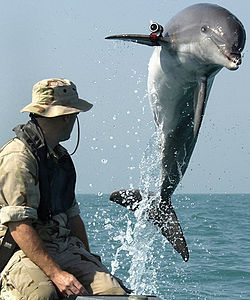Justin Gregg's Blog, page 7
March 12, 2013
Killer Ukrainian dolphins on the loose

Uh oh – it seems the Ukrainian Navy has a small problem on their hands. After rebooting the Soviet Union’s marine mammal program just last year with the goal of teaching dolphins to find underwater mines and kill enemy divers, three of the Ukrainian military’s new recruits have gone AWOL. Apparently they swam away from their trainers this morning ostensibly in search of a “mate” out in open waters. It might not be such a big deal except that these dolphins have been trained to “attack enemy combat swimmers using special knives or pistols fixed to their heads.” So if you are planning a family holiday to the Black Sea this week, I think it’s best you avoid any “friendly” dolphins that might approach – especially if they have KNIVES or PISTOLS strapped to their heads.
Here’s a documentary all about the former Soviet military dolphins, some of which have been sold to Iran, and a some of which are currently roaming the Black Sea looking for a good time.
UPDATE:
Here’s a more in-depth radio report on this subject from The Voice of Russia UK Edition
You can download/listen to the news report as an mp3 at this link.
Apparently, “The Ukrainian Defence Ministry has denied the reports.” But the Voice of Russia and the RIA Novosti appear to have sources at Sebastopol confirming that the dolphins escaped.
MORE UPDATES:
This Russian news agency is claiming that the escaped animals really did have firearms attached to their heads at the time they went missing (as far as I can tell via Google Translate). Crazy!
YET MORE UPDATES:
This news story has blown up on the interwebs, with reports suggesting that the escaped dolphins “are highly trained, intelligent, and can strike anywhere,” which is probably a slight exaggeration, as well as suggestions that the incident (first reported by RIA Novosti, but now found on every website known to man) in fact never happened at all. Now that journalists around the world are on the case (producing well-researched reports like this one from Wired), maybe we’ll soon get to the bottom of this story! Meanwhile, let’s not panic people!
UPDATE #4:
Now there is evidence that the news report of this incident, first reported by the Russian news agency RIA Novosti, was (maybe) based on false information, with RIA Novosti having received fake documents detailing a dolphin escape that never happened. So what are we to do with all these hilarious photoshopped images of dolphins with weapons strapped to their heads?
FINAL UPDATE:
This entire news story is now confirmed as bogus. Bummer!
February 21, 2013
Dolphins call each other by name?
An article titled “Vocal copying of individually distinctive signature whistles in bottlenose dolphins” is in the news this week. This is the latest in a series of studies from researchers at the University of St Andrews looking at how dolphins use “signature” whistles. Signature whistles are unique vocalizations that each dolphin develops at a young age that (sometimes) remains stable throughout their lives. It’s easy for humans, and presumably dolphins too, to hear the difference between dolphins’ signature whistles, which makes them useful for recognizing individual animals.
This study found that dolphins occasionally copy the signature whistles of their close associates (e.g., mothers and calves, male alliance partners), which is evidence that dolphins are using these whistles for friendly purposes, as opposed to territorial defense or aggression (which is often how bird species use copied sounds). The dolphins also appear to purposefully introduce very subtle changes in the copied whistles, which suggests they are not trying to deceive each other by pretending to be someone else.
It’s rare that animal communication results in animals having labels for objects in their environment – in this case it’s possible that the signature whistle is a kind of label that refers to individual dolphins. The most common examples of referential communication in the animal kingdom are alarm and food calls, which are found in diverse species (e.g., monkeys, rodents, chickens). Signature whistles are unique insofar as they are not used to refer to threats or food, but appear to refer to themselves, and possibly other dolphins. While we know from experiments that dolphins are able to learn both visual and acoustic labels for objects and concepts (something birds, primates, dogs and other animals can do as well), this is one of those rare cases where an animal might have a label for something in its natural communication system.
Unfortunately, this study was not able to tell us if dolphins copy the signature whistles of other dolphins in order to specifically refer to and/or get the attention of that individual or not. They might simply be copying the whistles/sounds which they hear most often in their environment and reproduce them as a general contact or distress call in times of trouble, which would explain why they copy the whistles of their close associates. It’s worth noting that the dolphins in this study didn’t actually copy each others’ whistles all that much – only 12 of the 121 individual dolphins in the capture-release scenario copied whistles at all, and then at a rate of only 0.18 copies per minute, which suggests that whistle copying is a rare-ish event. Although the media is keen to , this is a bit of an oversimplification or exaggeration insofar as we still don’t know how label-like or referential these whistles really are, of if the dolphins producing the whistles of their associates truly intend to refer to or label that animal or not. As the lead author of this study, Stephanie L. King, noted in an : “We still need to show that experimentally, but that’s why it’s quite exciting.” Indeed! Hopefully the St. Andrew’s group will get to the bottom of this in future studies.

King SL, Sayigh LS, Wells RS, Fellner W, & Janik VM (2013). Vocal copying of individually distinctive signature whistles in bottlenose dolphins. Proceedings. Biological sciences / The Royal Society, 280 (1757) PMID: 23427174
February 3, 2013
Altruistic dolphins help lost seal. Now with extra genital-buzzing!
The ocean is choc-a-block full of random acts of kindness these days. Recently we’ve heard about sperm whales adopting a deformed bottlenose dolphin, a dolphin that sought aid from a friendly diver, and now the latest offering; “altruistic” dolphins that help a lost seal find its way back home (video below).
It’s hard to tell from this video exactly what transpired since it’s a mashup of clips. The narrator seems fairly confident that the dolphins were keen to coax the little seal to safety, since he remarks at 1:30 that “with gentle nudges, the dolphins seem to be encouraging the young seal to swim.” On closer inspection, I do not see any “nudging” by the dolphins (they don’t touch the seal), but I do see at least one dolphin focusing his attention on the genital region of the seal – more than likely engaging in a behavior that scientists call “genital-buzzing.” It’s observed fairly frequently in dolphins, and its function is unknown. Here’s one description of genital-buzzing from this scientific article:
During courtship, discipline of conspecifics, or the pursuit/herding of sharks, the predominant vocalization produced is the “buzz” or “genital buzz.” This vocalization is a low frequency, high-repetition rate echolocation train that is directed towards the genital or mid-section of a conspecific, often by a male to a receptive female during courtship behavior.
So genital buzzing happens when dolphins are fighting with each other (perhaps buzzes directed at the genitals hurt), when chasing away predators (again, maybe the buzzing is uncomfortable), or when courting and getting ready to mate (perhaps the buzzing stimulates the potential mate, or is a way to ascertain if the female is ovulating). It’s hard to know what it might mean when a dolphin buzzes a seal’s genitals. In any event, it’s not entirely clear what was happening in this video. I suggest the following three possible explanations as to what was going through the dolphins’ heads in the above clip:
Scenario 1
“Doris, come quick! This poor seal needs our help.”
“You’re right Tim – let’s lead him to safety.”
“Poor little guy. I hope he makes it!”
Scenario 2
“Hey Doris, check out this floating meat-log. What do you think it is?”
“Wow Tim, that thing’s ugly! Well, I just buzzed its genitals and colorectal area, and whatever it is it’s not a dolphin.”
“Duh-doy – I knew that already! In any event, I wouldn’t mate with it.”
“Dude! Eew!”
Scenario 3
“This juvenile Mirounga angustirostris is an ideal candidate for our genetic-hybridization program. Let’s bring it back to the laboratory and harvest its organs.”
“Doris you fool, can’t you see we’re being filmed by a human?”
“Drat! And he’s using an SD camera no less! Couldn’t he afford a GoPro? Anyhow, we’ll have to come back for the specimen when the coast is clear.”
“Wait, let me buzz this seal’s genitals real quick – that really confuses these so called human ‘scientists.’”
*****
Tip: For more on altruistic behavior in dolphins and other animals, you’ll find a decent intro over at the Stanford Encyclopedia of Philosophy. Altruistic behavior is fairly widespread in the animal kingdom, and has had scientists thinking about how and why it evolved since Darwin first discussed the issue in On the Origin of Species.




